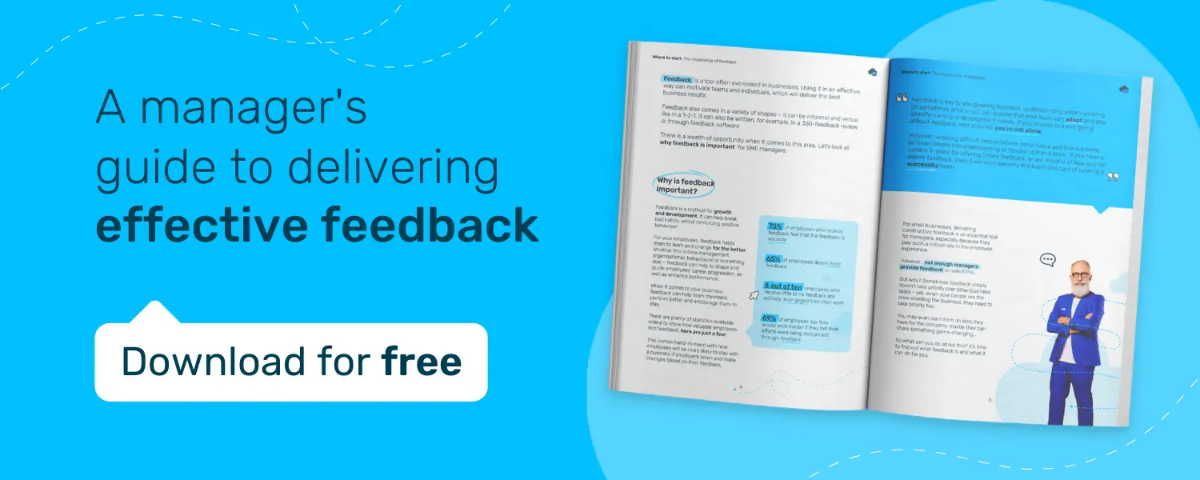We all know that feedback is important. But is it possible to diversify the amount and type of feedback we give, and receive?
Essentially, that's what 360 feedback offers. 360 feedback (also known as 360 degree feedback) is one method that can be used as part of the appraisal process. In this blog, we'll look at what 360 degree feedback is, how it can be used & the benefits for SMEs.
What is 360 feedback?
360 feedback is a process where someone receives holistic feedback from a range of people, usually colleagues. 360 feedback is confidential & anonymous, and usually provided by around 8-10 people (who have varying working relationships with the individual). This could include members of their direct team, managers, reports and other colleagues that they work closely with.
The aim is to provide as much of a well-rounded view as possible of the individual’s strengths and weaknesses, by compiling lots of varied feedback from a range of people. Employers can build a wider picture of employee competencies and effectively identify
.In most cases, respondents are asked to complete an online feedback form which consists of statements that they're asked to rate the individual against. The statements are designed to assess a range of workplace competencies. Likewise, the recipient of the feedback is also required to fill out a self-rating survey that contains the same survey questions.
How can SMEs use 360 feedback?
360 degree feedback is best used as a personal development tool. It's especially useful when respondents might not feel comfortable delivering feedback in another format, e.g. face-to-face. The intended outcome is that feedback recipients receive honest feedback & are made aware of how others perceive them. This can enable them to adjust their behaviours or develop their skills accordingly.
360 feedback should form part of the overall appraisal process, but shouldn’t be used to measure performance. This is because its main focus is on behavioural competencies, rather than job requirements & performance objectives.
What are the advantages of 360 feedback?
For organisations:
-
It provides qualitative and quantitative data that can be analysed on a departmental and company-wide basis.
-
It reinforces the link between competencies, behaviours and values that are required for the job role.
-
Employees are provided with a sound understanding of their strengths and weaknesses (which in turn gives them a basis for development).
-
It promotes the company’s commitment to employee development which is a great tool for recruitment & retention.
-
It provides a fair and transparent process that encourages an open culture that values feedback.
Employee advantages:
-
360 feedback means they receive information from a number of sources, providing a more comprehensive overview.
-
Gives them the opportunity to discover the opinions of people they work with and see how that compares to their own thoughts.
-
Increases self-awareness
-
Can improve teamwork - through an increased understanding of how others perceive them
-
Puts a focus on personal development and what they do well as well as what can be improved.
What are the disadvantages of 360 feedback?
For organisations:
-
The questions have to be well-thought out and well executed which means spending some time putting the process together.
-
If the feedback is not clear and well-communicated to the employee you can risk causing tension amongst your employees.
-
Those providing feedback might not feel comfortable to do so and feel pressured or stressed by the process.
Disadvantages for employees:
-
Lack of action following the feedback being given. It’s important to continue the process by acting on it.
-
Feedback may not be well-communicated and cause upset or distress to the employee.
-
Managers may prioritise uncovering their employees’ weaknesses rather than putting an emphasis on positive and constructive feedback
360 feedback to develop your business
Providing your employees with feedback that they can use to build on their development is an important part of working life. 360 degree feedback is just one method that employers and managers can use to do this and provides employees with a well-rounded view of their competencies and behaviour at work.
Breathe's free resource, a manager's guide to delivering effective feedback could help management within your business to successfully provide feedback (along with tools & resources to develop your team).

Author: Aimée Brougham-Chandler
An IDM-certified Digital Copywriter as of February 2023, Aimée is Breathe's Content Assistant. With a passion for guiding readers to solutions for their HR woes, she enjoys delving into & demystifying all things HR: From employee performance to health and wellbeing, leave to company culture & much more.





